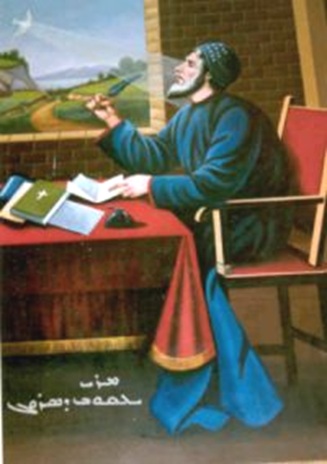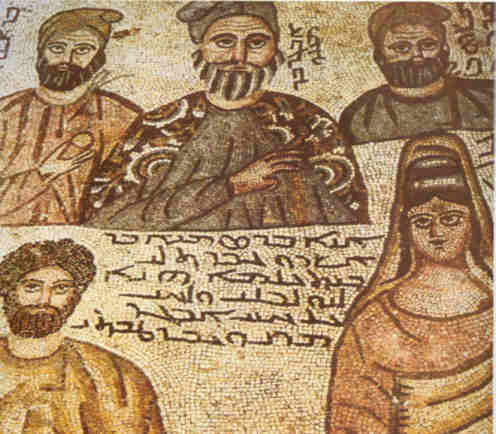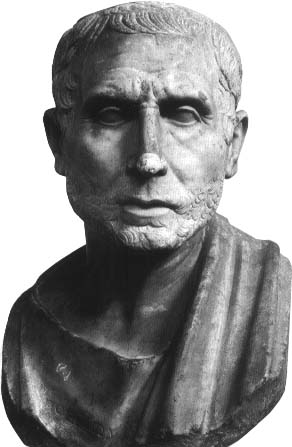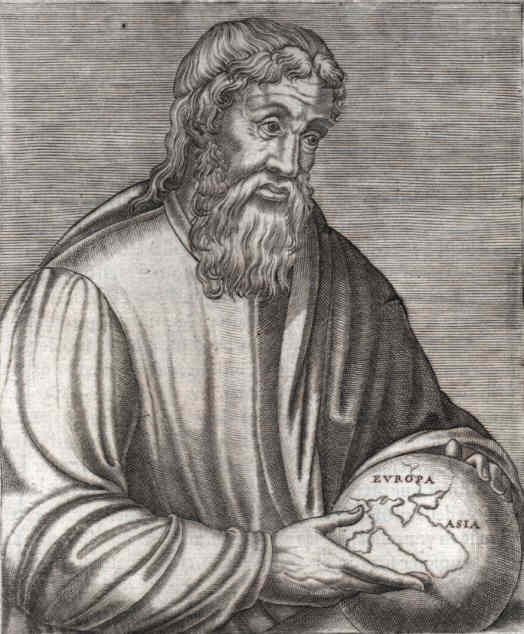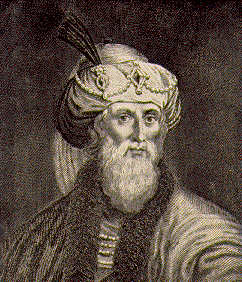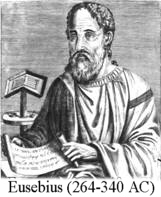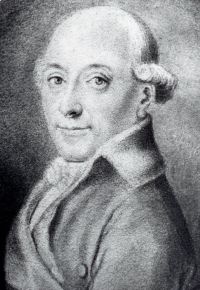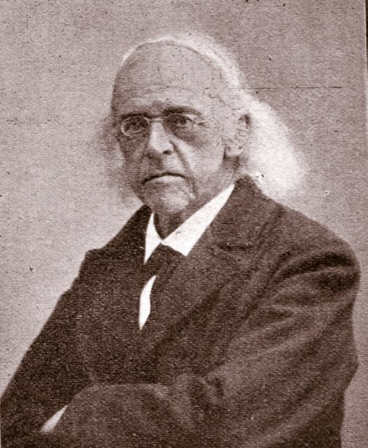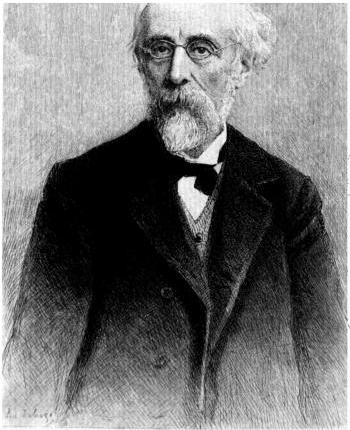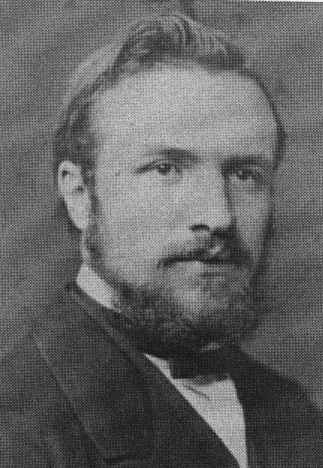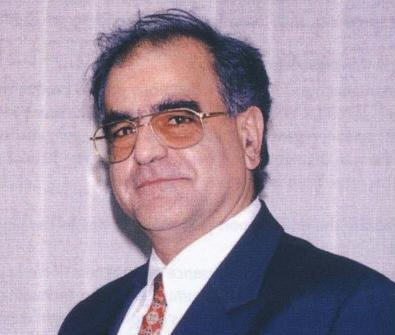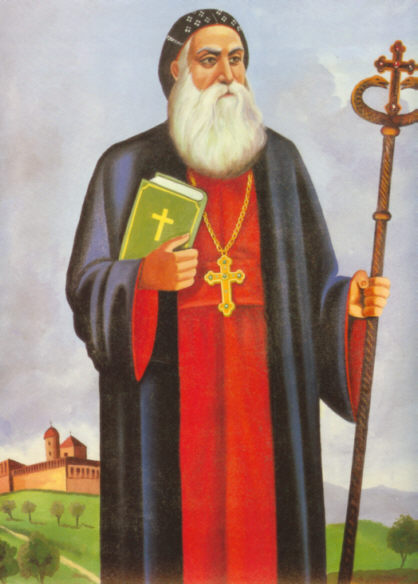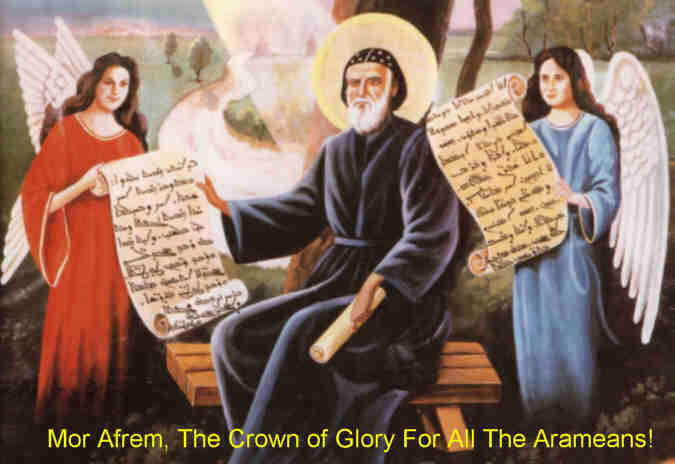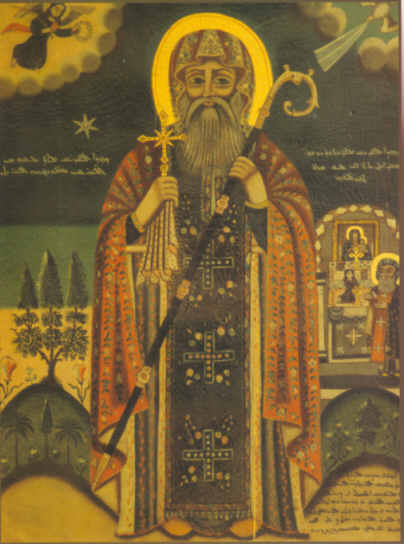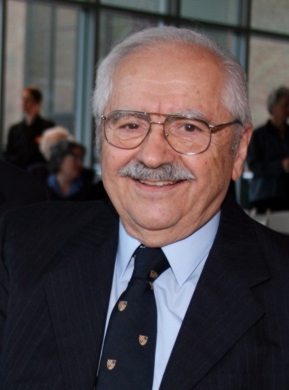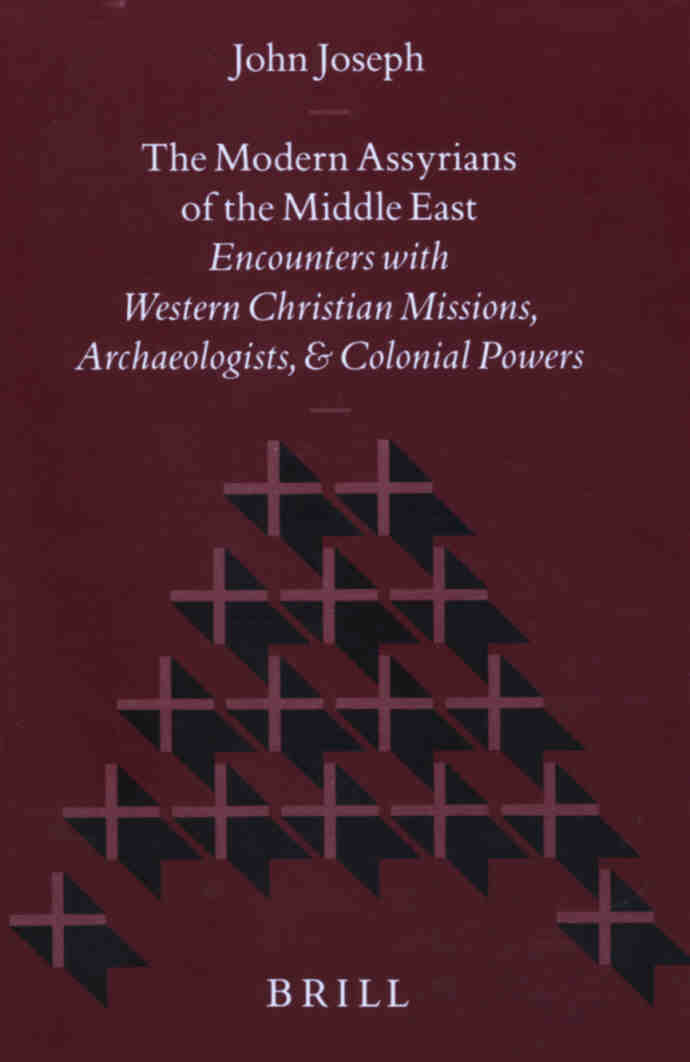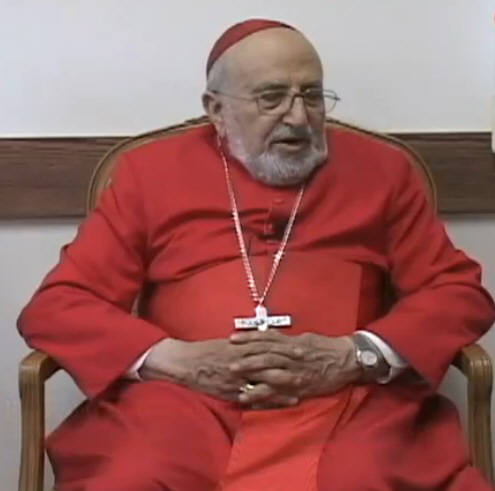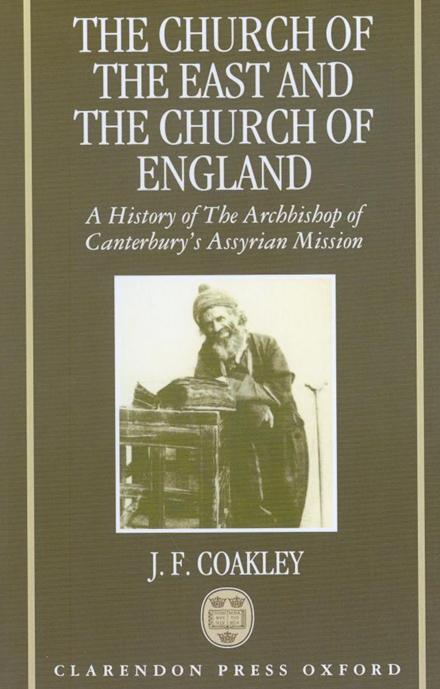|
Jacob of Sarug
Who made the East- Aramean Nestorians known as "Assyrians"?
SUA/WCA and allowing terrorism
Aramean history, history, culture and language, a six partite interview
26-6-2007: Aram Nahrin: the Aramaeans, the Bible, Christianity, and the West
27-6-2007: Aramaic: the Millennia Long Trajectory of the Global Language
28-6-2007: Gabriel Sengo opens the Gates of Aramaean Thought, Culture and Wisdom
2-7-2007: Do not Call the Illustrious Nation of Aramaeans by the Misnomer 'Assyrians'!
2-7-2007: Extermination of the Aramaean Nation: Results of an Anglo – French Plan
(Photo: wikipedia.org) The Historian Poseidonios from Apamea (ca. 135 BC - 51 BC), was a Greek Stoic philosopher, politician, astronomer, geographer, historian, and teacher. He says: " "The people we Greek call Syrians, they call themselves Arameans" From: See J.G. Kidd, Posidonius (Cambridge Classical Texts and Commentaries, 1988), vol. 2, pt. 2, pp. 955-956)
(Photo: wikipedia.org) Strabo (born 63 BC or 64 BC, died ca. 24 AD), a Greek historian, geographer and philosopher is mostly famous for his Geographika ("Geography") He says: "Poseidonius conjectures that the names of these nations also are akin; for, says he, the people whom we call Syrians are by the Syrians themselves called Arameans." (From: The Geography of Strabo, translated by Horace Leonard Jones and published in Vol. I of the Loeb Classical Library edition, 1917, Book I, Chapt. 2, 34)
(Photo: http://www.ccel.org) Flavius Josephus (c. 37 – c. 100 AD (or CE)) was a 1st century Jewish historian and apologist of priestly and royal ancestry who survived and recorded the Destruction of Jerusalem in 70 and later settled in Rome. He says: ""Aram had the Arameans, which the Greeks called Syrians."" (From: Antiquities of the Jews, translated by William Whiston in 1737, Book I, Chapt. 6)
Eusebius of Caesarea (c. 275 – May 30, 339), was a bishop of Caesarea in Palestine and is often referred to as the father of church history because of his work in recording the history of the early Christian church. He says: ""and from Aram the Arameans, which are also called Syrians" (From: Sebastian Brock, "Eusebius and Syriac Christianity," in Harold W. Attridge and Gohei Hata, eds., Eusebius, Christianity, and Judaism (Leiden 1992), p. 226)
Abu Al-husayn 'ali Ibn Al-husayn Al-mas'udi, born 895 in Baghdad [Iraq] and died 957 in al- Fustat [Egypt], was a historian and traveler, known as "the Herodotus of the Arabs.” He was the first Arab to combine history and scientific geography in a large-scale work. On Tur Abdin he says: "Tur Abdin is the mountain where remnants of the Aramean Syrians still survive." (From: Michael Jan de Goeje: Bibliotheca Geographorum Arabicorum III, Leiden 1906, 54, I)
Prof. Dietrich Hermann Hegewisch born Dec. 15, 1746 in Quakenbrück [Germany] and died April 4, 1812 in Kiel, was a prolific german historian at the University of Kiel with a wide span of interests. He says: "Do not the Syrians, as they are usually called, or the Arameans, as they in fact are termed, deserve more attention in world history than they are usually given?" (From: D.H. Hegewisch: Die Aramäer oder Syrer; ein kleiner Beitrag zur allgemeinen Weltgeschichte, Berlinische Monatschrift, 2, 1794, p. 193)
On Page 197 he says: "The names Syria, Assyria, Mesopotamia, Babylon, etc. stem from the Greeks, who were not familiar with the true geography of these lands when the names first started to be used. Later, partly because of continuing ignorance and partly because of convenience despite having accurate knowledge, they persisted in using them since it would have required something of an effort to give up the old, familiar names and divisions of the countries and switch to the new ones, even if they were more accurate. The old, true, and single name of these lands is Aram; it is mentioned numerous times in the Bible of the Old Testament, and Greek scholars were also familiar with it and probably described the population of these areas as Arameans, though seldom, as they usually continued to use the term Syrian, which had been familiar to the Greeks."
On page 307 he says: "The Syrians or Arameans were not merely a numerous and large people, they were also a much cultivated people."
(Photo: http://portrait.kaar.at) Prof. Theodor Mommsen born Nov. 30, 1817, Garding, Schleswig [now in Germany] died Nov. 1, 1903, Charlottenburg, near Berlin, was a German historian and writer, famous for his masterpiece about the History of Rome. He received the Nobel Prize in Literature in 1902. He says: "the history of the Aramaean or Syrian nation which occupied the east coast and extended into the interior of Asia as far as the Euphrates and Tigris" (From: The History of Rome, written between 1854 and 1856, Leipzig, by Theodor Mommsen, Book First, Chapter One) "the Arameans defended their nationality with the weapons of intellect as well as with their blood against all the allurements of Greek civilization and all the coercive measures of eastern and western despots, and that with an obstinacy which no Indo- Germanic people has ever equalled, and which to us who are Occidentals seems to be sometimes more, sometimes less, than human." (ibid, Book Third, Chapter One)
(Photo: wikipedia.org) Prof. Theodor Nöldeke born March 2, 1836 in Harburg near Hamburg, died December 25, 1930 in Karlsruhe, was the leading german semitic scholar, who studied at Göttingen, Vienna, Leiden and Berlin. He says: "The main body of the population of all these wide landscapes from the Mediterranean Sea to beyond the Tigris belonged to a certain nationality, that of the Arameans." (From: Th. Nöldeke: Assyrios Syrios Syros, in Zeitschrift für klassische Philologie, Hermes 5, Berlin 1871, p. 460)
On page 461 he says: "It is well understandable that people have started to transfer the name of the country to the most important nationality and so the name 'syrian' was apprehended ethnological and was equated with 'aramaic'."
On page 468 he says: "Since the times of Alexander [the Great], if not already somewhat earlier, people have started to transfer the name of the Syrians exclusively over the prevailing in Syria nationality, and in this way this originally political-geographical term became an ethnological one that was identified with the local Arameans."
"From the time the Greeks came to have a more intimate acquaintance with Asia, they designated by the name of Syrians, the people who called themselves ´Arameans’.” (From: Th. Nöldeke, Kurzgefasste Syrische Grammatik (Leipzig, 1880), p. XXIX)
"Regarding the name of this nation and its language is the original 'Aramean’ in essence also the only one [sic], that for the employment of the present-day scholarship as yet strongly fits.” (From: Th. Nöldeke, "Die Namen der aramäischen Nation und Sprache,” in Zeitschrift der Deutschen Morgenländischen Gesellschaft 25 (1871), p. 131)
(Photo: www.doaks.org) Karl Eduard Sachau born 20 July 1845 and died 1930 was a German orientalist. He was 1872 professor at the University of Vienna, and in 1876, professor at the University of Berlin, where he was appointed director of the new Seminar of Oriental languages in 1887. He is especially noteworthy for his work on Syriac and other Aramaic dialects. He says: "The nation of the Arameans: This national name later, mainly in consequence of Jewish-Christian literature influences, gave way to the Greek designation Syrians." (From: Verzeichnis der Syrischen Handschriften der königlichen Bibliothek zu Berlin von Eduard Sachau 1. Abteilung, Berlin 1899, Vorrede I)
|
Aramean people: Aramean people (not to be confused with ‘Armenians’) speak Aramaic, the language spoken by Abraham, Moses and Jesus. They are the indigenous people of what was called in ancient times Aram- Nahrin, in our days it is called ‘Mesopotamia’. Some Arameans today identify themselves with “Assyrians”, because of the spiritual colonial hate generating activities of the Western missionaries and diplomats in the Middle-East in 16th and 19th centuries. Other Arameans became known as “Chaldeans”. However all of them are Arameans.In Turkey, the Arameans are called: Süryani. In Arabic they are called Al- Suryan. Gabriel Sengo opens the Gates of Aramaean Thought, Culture and Wisdom 28-6-2007- Part 3 At the same time, Mr. G. Sengo castigates the unacceptable current situation of oppression and confusion, and the persecution of the Aramaic Language and the Aramaean Culture in numerous countries of the Middle East where the Aramaeans are not even recognized as an ethnic – linguistic group.
By Prof. Dr. Muhammad Shamsaddin Megalommatis, Orientalist Source: http://www.buzzle.com/articles/gabriel-sengo-opens-gates-aramaean-thought-culture-wisdom.html http://www.americanchronicle.com/articles/viewArticle.asp?articleID=30875 In this third part of Mr. Gabriel Sengo’s interview’s, we focus on issues related to Aramaean Wisdom, Science, Philosophy, Theology and Literature. The Chairman of the Aram Nahrin Organization presents a summarized outline of the Christian Aramaean contribution to the formation of the world civilization. At the same time, Mr. G. Sengo castigates the unacceptable current situation of oppression and confusion, and the persecution of the Aramaic Language and the Aramaean Culture in numerous countries of the Middle East where the Aramaeans are not even recognized as an ethnic – linguistic group. Understanding the Armaean Impact of the formation of Cultures and Civilizations will be the key to Peace in the Middle East. An Interview with the Great Aramaean Intellectual and Activist, Gabriel Sengo, Chairman of the Aram Nahrin Organization - What books are today written in Aramaic? - The books available in Aramaic deal with amongst other things history, theology, exegeses, philosophy, music, medicine, language, poetry, mathematics and astronomy. When we talk about books written in Aramaic, it is necessary to talk about the authors of these books, for they contributed to the wellbeing of mankind. The Aramean scholars, excelled in their wisdom and knowledge in comparison with their contemporaries, enlightened the world of their time not only with theological science but also with regular science. The Globally Unique Impact of Aramean Erudite Scholars The Aramean scholars were not only the teachers of Arabs, Armenians and Georgians, but have also translated and further developed the complete science of their era into Arabic which later was transferred to the West. In the East it was the Aramean scholars who provided the essential link between Greek and Arabic. In the 7th century the scholarship in the Greek-speaking world declined. However the momentum of scholarship and secular learning of that time was kept up by brilliant Aramean scholars, for example: Severus Sebokht, Athanasius of Balad (Eski Mosul), Jacob of Edessa and others. The early Abbasid Caliphs were provided with basic intellectual tools, the hall-mark of the Greek philosophical tradition, by the Aramean scholars. The commentaries and compendia of Aramean scholars of later date, like for example, Iwannis of Dara, Mushe Bar Kipho, Dionysios Bar Salibi, Jacob Bar Shakko, and above all Bar Hebraeus, the library from the 13th century, testify about the brilliancy of their predecessors. The Arabs also adapted many of the Aramean melodies, tunes and poetical metres which were invented by scholars like Bardaisan, Mor Ephrem, Mor Balai, and Mor Jacob of Sarug. Some of the theories which were well accepted by the West, for example: the theory of Harder "The man is a small world" was treated by Ahudemeh (6th century), the famous Catholicos of the East Syrian "Nestorian" Church who became martyr. The theory of Galileo, the astronomer, has already been treated by the bishop of Edessa (10th century) in his book "The cause of all causes". The Aramaic schools of Antioch, Edessa, Nisibis (the first university in the world) and Seleucia – Ctesiphon - established by the brilliant East - Aramean scholar Catholicos Aba I of the Church of the East in 541 AD (since 1976 falsely known as "the Assyrian Church") were the sources which delivered giant scholars in their era and were the centres where many disciplines of science were taught, developed and transferred to other nations. When these schools eventually stopped, for various reasons not need to discuss here, the scholarship continued in the monasteries. Three of these famous Monasteries are: - the Monastery of Eusebona (established second half of 4th century), which is situated near Qal’at Simon in northern Syria, - the Monastery of Tell Ada (established in the middle of the 4th century), and - the Monastery of Qennesrin, situated on the east bank of Euphrates, opposite to Dura Europos (established in first half of the sixth century by John Bar Aphtonia (d. 537 AD). The Monastery of Eusebona was famous for its scholarship. Among the brilliant scholars which it brought about were two Patriarchs of the 7th century, namely Yuhannen II Abu Al Sadrat (d. 648 AD) and Athanaisus II of Balad (Eski Mosul, d. 687 AD). Below, a few of these revered scholars will be presented to the reader. The scope of this questionnaire does not allow us to mention all of them. Therefore we will restrict ourselves to only a few of the most prominent. Poetry * Ephrem the Syrian (d. 373 AD). A pupil of the great ascetic St. Jacob of Nisibis (d. 338 AD) was the most brilliant and the greatest of all Aramean poets, plus a highly creative ideological thinker. He was so famous that many of his works were translated amongst others into Greek, Armenian and Arabic. * The second brilliant scholar and poet after Ephrem was Jacob of Sarug, also called "The Teacher". He was born in the middle of the fifth century in Kurtam (Euphrates) and was educated at the famous Aramean university of Nisibis. He was renowned for his verse homily. In 519 he was appointed as the bishop of the region capital Batnan (in Sarug).* A third scholar who can be mentioned is Balai of Qenesrin (early fifth century) near Aleppo, a notable poet.
Medicine: The famous Aramean physicians of Baghdad - the Abbasid capital The historian of medicine, Guido Majno, tells in his book "The Healing hand: Man and Wound in the Ancient World" about the Aramean physicians of Jundishappur (= Beth Lapat): "They were foremost among the crowd of unknown, unsung scholars who, during the so-called Dark Ages, cared to transmit the knowledge of antiquity. Without their labours, some of our roots would have withered- and much of the story that I have shared with you in this book could not have been told". The quality of the Aramean scholars was indeed also noticed by the Abbasid Khalifs, in particular Al - Mansur (754-775), Al- Mahdi (775-785) and Al- Ma’mun (813-833) who set up a huge translation movement to transfer the ancient knowledge into Arabic and thus to the Islamic world. And who were more qualified and skilful for this giant project? Of course, the Aramean scholars, for they were masters in Aramaic, Greek, Arabic and in every field of the science. That was the reason the Great Arab philosopher, Al - Farabi (d. 950-951 AD) said regarding the history of the philosophy of medicine: starting with the ancient Greeks from Alexandria via Antioch (the Arameans of course) to the Abbasid capital of Baghdad! A historical – political commentary is imposed in this case! It is a
terrible irony indeed! In our days, the Arameans of Iraq are excluded
from the Iraqi constitution and they are treated with extermination by
fanatic Islamic groups! * Hunayn Ibn Ishaq (809-873) and his son Ishaq Ibn Hunayn: the masters of the translation craft. Thanks to the renowned Aramean physicians in Baghdad and marvellous scholars like Hunayn, the medical knowledge of the Greco-Roman world of Late antiquity was transferred to Arabic and thus to the Islamic world of the Middle Ages. The work of Hunayn Ibn Ishaq on medicine immensely influenced over many centuries not only the Islamic world, but also Europe. The works of Hunayn survived both in Arabic as well as in Aramaic. Once the Arabic version was translated into Latin and reached Western Europe, the textbook of Hunayn was treated as a standard introduction to medicine until the sixteenth century. * Physician Gabriel of Sinjar (7th century). He was well respected by the Great Sassanid Shah Khusraw (Chosroes) II because of his skills in medicine. * Sargius of Res’Aina (d. 536). A revered scholar and translator of medicine. * Josef, the Catholicos of the Church of the East (551-567). He was a physician and respected for his skills by Sha Khusro I. Science, Philosophy, Theology and Astronomy * Bardaison. "The Aramean Philosopher" (154-222) was active at the court of the Aramean king Abgar the Great of Edessa, and a central figure of philosophical dialogue on the subject of fate, free will and predestination, known under the title "The Book of The Laws of Countries". * Rabbula of Edessa (411-435). Exceptional writer in Greek as well as in Aramaic (Syriac). *Aba I, the Catholicos of the Syrian Church of the East (540-552). He was the founder of the famous Aramean school of Nisibis and his learning impressed Cosmas Indicopleutes, the famous "Sailor of the Indian Ocean". * Philoxenos of Mabbug (d. 523). A great theologian. He produced many works. Theological Christological prose, biblical exegeses, other works in the form of letters. He also wrote three anaphorae, a baptismal service, etc. * Daniel of Salah (Tur Abdin, Salah mid 6th century). Extensive commentary work on the Psalms. *Babai the Great (d. 628 AD). He was educated at the famous university of Nisibis, and he became the main East -Aramean "Nestorian" author on Christology. He was the superior of the Monastery of Abraham of Kashkar (Mount Izlo, Tur Abdin). *Severus Sebokht (667 AD). The famous master of St. Jacob of Sarug. Severus was a top scholar of astronomy and philosophy. This includes treatises on the Astrolabe and on the constellations. On logic include his work on syllogisms. * Isaac of Nineveh, or Isaac the Syrian (late 7th century). From Beth Qatraya, he was the most widely read of all Aramean authors, his works have been translated into Greek and today are available in more than 10 West - European languages. * Patriarch Athanasius II of Balad (Eski Mosul, 683-687). Translator of philosophical works, Prophyry’s to Aristotle’s logical works, and a collection of letters of Severus. * Jacob of Edessa (640 - 708). Prolific scholar and translator, pupil of Severus Sebokht, became bishop of Edessa and later for 9 years the bishop of the famous monastery of Tel Ada. Wrote amongst others a learned commentary on the six days of Creation, philosophical handbook, letters on specific topics, liturgical books, questions & answers on canon law, biblical scholia on exegeses, grammar, chronicle, etc. * Yohannan Bar Penkaye. East - Aramean writer (late 7th century), whose most important work was a summary of World History in 15 books. *Catholicos Patriarch of the Syrian Church of the East, Tmotheus I (of Arbil, d. 823). Timotheus was a great scholar who enjoyed the respect of the Abbasid caliph because of his wisdom and knowledge. * Anton of Tikrit (9th century). He wrote 5 books "On Science of Rhetoric". Also on Providence, and on Myron. *Job of Edessa (early 9th century). His book "The Book of Treasures" deals with metaphysics, psychology, physiology, chemistry, physics, mathematics, meteorology, and astronomy. * Iwannis of Dara (first half of the 9th century). Author of many important philosophical and theological works, including treaties On The Soul, On Creation, On the Resurrection of the Body, etc. *Mushe Bar Kipho (903 AD). A brilliant scholar and bishop of the area between Mosul and Tikrit. Important and extensive works cover philosophy, theology, exegesis and liturgy and many other profession of the science. * Abu – l’ Hasan Bahlul. East - Aramean "Nestorian" of the 10th century, compiler of one of the largest medieval Aramean lexicons. * Emmanuel Bar Shhare (second half of the 10th century). Author of an extensive verse commentary on the Six Days of Creation and other important works. *Isho Bar Ali (d. 1001). East - Aramean Physician and author of an important lexicon. * Dionysis Bar Salibi (d. 1171). He was a renowned scholar, bishop of Marash and Metroplitan of Diyarbakir (Amid), and was known by contemporaries as "the eloquent doctor, the star of his generation, and a lover of labour like Yacob of Edessa". His works include a commentary on the entire Bible, liturgical commentaries, apologetic, commentary on Porphyry’s Introduction to Aristotle’ s logical works, Organon, and three Anaphoras. * Patriarch Michael the Great (1166-1199). He was a brilliant scholar, born in Melitene (Malatya), and became Patriarch at the Monastery of Mor Barsaumo (Malatya). His incredible World Chronicle extending from Creation to his own days is a historical source of invaluable importance. * Gregorios Abu ‘l Faraj, Bar Hebraeus. He was born in 1225/26 in Melitene (Malatya, Turkey) and died 30 July 1286 in Maragha (NW Iran), the city with the greatest number of observatories in the world. Because of his immense knowledge on various fields of science, he is known as "Library of the 13th century". His works include, history, theology, Aramaic grammar, philosophy, astronomy, physics, poems, medicine treatises, etc. * Yohannon Bar Zobi (late 12th century). He was one of the most learned East - Aramean scholars of his time. His works include philosophy, grammar and liturgy. Late Medieval and Modern Aramaean Erudite Scholars * Israel of Alqosh. He lived in the 16th /17th century, East - Aramean author of several poems in classical Aramaic, known as the first poet who wrote in modern Syriac (Aramaic). * Patriarch Joseph II of Diyarbekir. East - Aramean Chaldean (1667 - 1712) who was a prolific author and translator. Amongst his books: The Polished Mirror, The Magnet, commentary on the Mysteries and Porphyry’s Introduction to Aristotle’s Logic. * Metropolitan Shemun Basileios of Tur Abdin (killed in 1740). He was one of the most important Syriac (Aramaic) writers of 18th century, and wrote both in verse and prose. Amongst his works: Book of Theology, The Armour of Confession, Hope of Faith, Chariot of Mysteries, etc. * Toma Audo (1855 - 1918), East - Aramean Chaldean bishop of Urmia, who wrote the famous lexicographical Aramean - Aramean dictionary (Mosul 1897). * Ignatius Afrem Barsauwm I (1887 - 1957). He is also known as the "Star of the Middle-East"; he was a noted scholar and the writer of amongst others important works on Aramean Literature and History, including the History of Tur Abdin. * Mor Philoxenos Yuhanon Dolabani (1885 - 1969). The Metropolitan of Mardin, prolific scholar, poet, editor and translator. * Gabriel Paulus (1912 - 1971). Professor of Aramaic at the Lebanese University, who promoted the use of classical Syriac (Aramaic). Along with Ghatas Maqdasis Elyas, he translated some French works into Syriac. * Asmar Al - Koury (1916 - 1992). Born in Tur Abdin (Ainwardo), he studied in Deir Zafaran (Mardin, Turkey) under the famous Yuhannen Dolabani. He wrote extensively in Aramaic, both prose and verse; amongst other works, two volumes on History of the Aramean people in Mesopotamia were posthumously published in 1998 (Sweden). Of course, there are many more Aramean authors; however, we believe the aforementioned examples suffice to give readers an approximate impression. - How many million people speak Aramaic today, and where do they live? Rough estimates: 2-2.5 million. They live in the Middle-East, Europe, United States, Australia and Canada. - Where do they learn Aramaic? In Churches, monasteries, and seminaries, like for example the Mor Afrem Seminary in Lebanon, and since 2000 the Seminary in Syria. - In what countries is Aramaic taught in the Primary and Secondary education? There is no country in the world where Aramaic is taught in the Primary and Secondary education. All the parts of the interview:
Copyright © Aram-Naharaim Organisation
|
Letters to governments and international institutions
Aramean Spiritual/ Physical Genocide
Fake News on the Aramean nation:
Professor Dr. John Joseph. 5-7-2008: Assyria and Syria: Synonyms?
In a letter to the author (John Joseph), dated June 11, 1997, Patricia Crone wrote that she and Cook “do not argue that the Nestorians of pre-Islamic Iraq saw themselves as Assyrians or that this is what they called themselves. They called themselves Suryane, which had no greater connotation of Assyrian in their usage than it did in anyone else…. We take it for granted that they got the modern Assyrian label from the West and proceeded to reinvent themselves… Of course the Nestorians were Arameans.” (Page 27, footnote 94)
Professor Dr. Muhammad Shamsaddin Megalommatis 28-6-2004: Progenitor of Wars and Tyrannies: the Falsehood of Pan-Arabism
10-8-2005: The Aramaeans' rise will transfigure the Middle Eastern Chessboard
18-12-2008: Syriacs, "Assyrians" and "Chaldaeans" are all Aramaeans
16-12-2008: Pseudo-Assyrians, Pseudo-Chaldaeans, and the Cultural – National Needs of the Aramaean Nation
Patriarch Emmanuel III Delly
13-5-2006: Is there an Assyrian cause in Iraqi Kurdistan?
2-8-2005: IRAQ's Modern History. The Arab Majority and The Minorities
“The Church of the East and the Church of England: A History of the Archbishop of Canterbury's Assyrian Mission “ is the title of the book written by J.F. Coakley and published in 1992.
On page 147 Coackly reports about a dispute between Arthur Maclean, head of the Archbishop of Canterbury's Assyrian Mission from 1886 to 1891, and Hormuzed Rassam, the brother of Christian Antun (Isa) Rassam; a Chaldean family from Mosul. We read: “As he (Maclean) insisted, the ‘Syrians’ called themselves that, never ‘Assyrians’; …… to apply the name ‘Assyrians’ to these Eastern Syrian Christians appears to me either an error, or else pedantry. There is really as far as I know no proof that they had any connection with the Old Assyrians. ....... ..... Why should we invent a name when we have such a very convenient one, used for centuries, at our hand? I can understand that one living close to the ruins of Nineve should have a fit enthusiasm of Old Assyria; but is it common sense to cast aside a name used by the people themselves, and to invent another for them of very doubtful applicability? “
|
